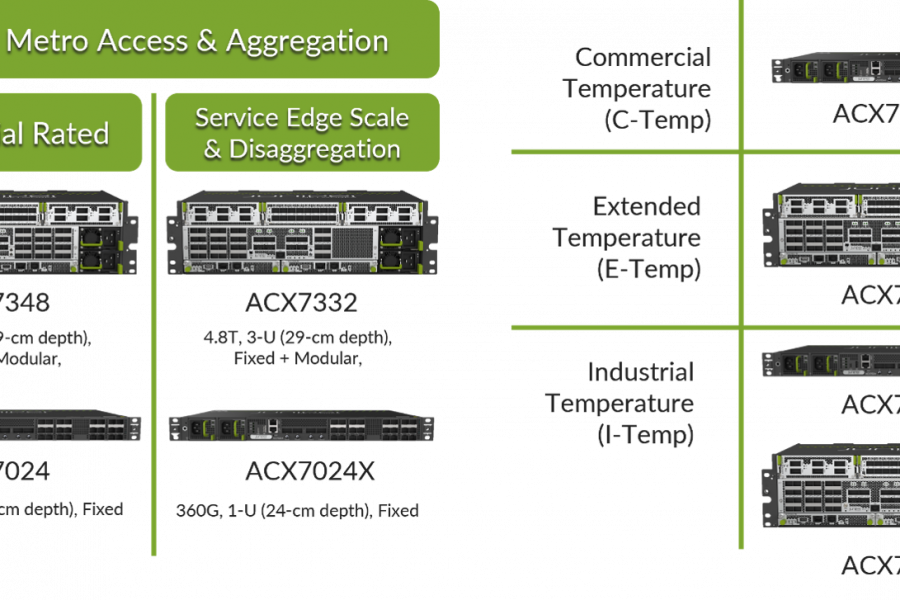Living on the Edge: New MX Series products with groundbreaking Trio 6 silicon offer a versatile foundation for the future
When most people talk about living on the edge, they mean engaging in extreme, adventurous – even risky – behavior. That can seem a far cry from the way “edge” is often used in the networking space, and specifically multi-service edge nodes, where diverse business and residential services traditionally come to life. But is it really all that different? More and more, that other way of thinking about life on the edge—unpredictable, constantly changing, even a little scary—seems to apply.
Service provider organizations planning a multi-service edge strategy know this firsthand. They need to account for exponentially growing connections and an exploding diversity of multi-service use cases, each with its own list of specialized requirements. They also need to support demanding new consumer broadband experiences, business applications and security capabilities. And beyond the demands that are known, they need to prepare for the unknown, too, and ensure that the investments made now can continue to serve customers five years down the road – maybe longer. It’s a lot to contend with. But the good news is, service providers don’t have to do it alone.
In a recent blog, my colleague, Brendan Gibbs, VP of Automated WAN Solutions, discussed Juniper Networks’ multi-silicon philosophy, and why Juniper believes purpose-built ASICs offer a better solution than trying to serve every network domain with one-size-fits-all silicon. This is a powerful strategy. Today, Juniper is thrilled to announce three new additions to the industry-leading Juniper MX Series routing portfolio, all based on the latest-generation of Trio ASICs – Trio 6. With a chipset designed specifically for the unique needs and opportunities of the multi-service edge, these products deliver massive logical scale, flexibility and programmability, with the densest per-slot throughput on the market. So, even if we don’t know exactly what the future holds, we can make sure your network is ready.
Meeting the Growing Multi-Service Edge Challenge
Big numbers are often used to describe large-scale operator networks. But the multi-service edge is where all that scale and service intelligence turn into individual services, experienced by hundreds of thousands of unique business and residential customers.
Here, each logical service endpoint needs its own unique encapsulation, encryption and/or tunneling. Each endpoint can have its own SLA, requiring its own customized quality of service (QoS), telemetry and counters configured to measure usage and performance against SLAs and billing. As cybersecurity threats grow, each service instance may also require unique security controls to protect against DDoS attacks, malware and other threats. The list goes on. And zooming in on the individual service-levels instead of thinking big picture is not realistic. Somehow, one must meet these highly specific expectations for each service instance for hundreds of thousands of customers at once.
Introducing Juniper’s Trio 6-based MX Portfolio
The new Trio 6 chipset marks the sixth generation of Trio silicon for Juniper’s industry-leading MX Series routers, built from the ground up for the unique requirements of the multi-service edge. And today, Juniper is announcing three new multi-service edge offerings, each powered by the Trio 6 ASIC.
- MX10K LC9600 Line Card: The LC9600 line card delivers the same MX Series DNA that’s made Juniper the industry leader for years in a high-density solution optimized for the multi-service edge. It delivers 9.6 Tbps per slot throughput and, along with the existing LC480 line card, provides the flexibility to scale from 1GE to 400GE interfaces in a single MX10K platform – no forklift upgrade required. The LC9600 has superb power efficiency that it inherits from Trio 6 which operates at just 0.09 Watts/G, substantially reducing power consumption by 70% over the previous generation of Trio. And it brings the full breadth of multi-service functionality in Juniper’s Junos OS, with the versatility to deliver disparate edge services concurrently (residential, business, mobile, video, converged P/PE infrastructure, data center interconnect and more). To address growing cybersecurity threats, the LC9600 also offers embedded MACsec on each port, to protect customers with no throughput performance penalty.
What about when the same kind of flexibility and logical scale are needed but in a smaller package? Now, service providers can tap into the power of the Trio 6 chipset in two smaller form factor multi-service edge routers specifically designed for power- and space-constrained environments. These new platforms reduce carbon footprint and operating costs, while delivering the flexibility to economically scale out services anywhere in the network.
- MX10004 Multi-Service Edge Router: Designed to meet the most demanding service edge requirements, the MX10004 is a modular 7RU, 4-slot line card configuration that uses the same MX10K universal router chassis operators know and love. That means protecting and building on Juniper investments by continuing to use the same MX10K line cards currently deployed (LC2101, LC480) along with the new LC9600. When fully loaded with LC9600 line cards, it operates with noteworthy power efficiency—among the lowest of any modular router on the market today. And it delivers all of this with the same comprehensive MX feature set and the same MX DNA.
- MX304 Compact Multi-Service Edge Router: For environments where space and power are at an absolute premium, the MX304 provides a highly compact, 2RU platform with the flexibility to scale out services with 3.2 Tbps and 4.8 Tbps, in redundant and non-redundant configurations, respectively. It redefines per-rack-unit economics, enabling support for a wide range of demanding edge requirements (business, residential, mobile, cable, data center and more) anywhere in the network. And, like Juniper’s other Trio 6-based platforms, the MX304 delivers exceptional power efficiency.
All three of these solutions draw on Trio 6 silicon that’s designed and optimized for the highly specialized needs of the multi-service edge. And, unlike some vendors’ new chipsets, which look to show up in actual products sometime in the distant hazy future, Trio 6 capabilities can be used today. The LC9600 Line Card is orderable now, and the MX304 and MX10004 will be orderable in 1H and 2H of this year, respectively.
Building Tomorrow’s Multi-Service Edge
Can anyone ever truly feel comfortable living on the edge? Maybe not. After all, as the saying implies, living on the edge means pushing boundaries, facing the unknown, embracing change. And that’s how it should be. In the coming decade, it’s at the service edge where operators will build the foundation for the most complex and important business and residential use cases. No one should want to try to do it with one-size-fits-all-silicon that’s not optimized for what multi-service edge requires.
At Juniper, we believe the uniquely diverse and demanding challenges of the multi-service edge require specialized capabilities, and a silicon architecture designed from the ground up to deliver them. We think if the exacting requirements of individual end-customers are going to be met, even as boundaries are pushed and unknowns exist, it’s more important than ever to have the right tools for the job.
Just as Juniper has done for the last two decades, we will continue delivering groundbreaking silicon and routing solutions to help service providers not just live on the edge, but thrive there.
To learn more, visit our service provider and cloud operator solution pages.


